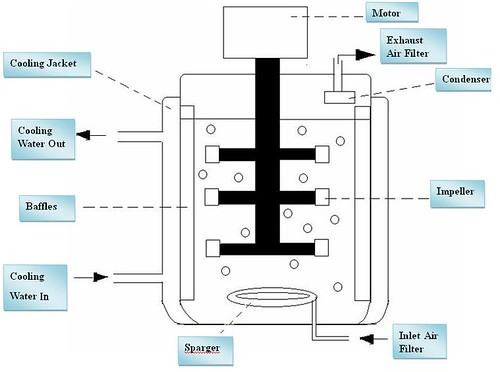=D
Experiment No. 1 Familiarisation with the Bioreactor and its Operation
Objectives
- To familiarize students with the parts and components of microbial and mammalian Bioreactors
- To introduce the basic operation procedure of a bioreactor.
First day of the practical,everybody "look forward" to this. (Here come the project!!)
Well,luckily our lecturer is Mr Ong (wahaha...)so i guess some girls will enjoy the practicals :P (*ehem* i never mention the names :P)
So this is how a fermenter look like :

And the real one will be like this:



| Part of Bioreactor | Part of Bioreactor |
| Motor | Provide energy to the impeller in order to generate it. |
| Impeller | Mix the media by stirring. |
| Sparger | Introduces air in the form of bubbles |
| Baffles | Prevent vortexing of culture. |
| Inlet Air Filter | Remove contaminants; adjust flow rate |
| Exhaust Ait Filter | Filter used air moving out to the environment |
| Rotameter | Measures the flow rate of the air. |
| Pressure Gauge | Measures the pressure. |
| Temperature Gauge | Measures temperature, giving the culture broth an appropriate warmness to maintain in. |
| Coolinng Jacket | Control Temperature |
| pH probe | Measures pH |
| Dissolved Oxygen Probe | Measures the amount of dissolved oxygen |
| Foam Probe | Detect the presence of foam |
| Acid | Added when pH too high (Alkaline) |
| Base | Added when pH too low (Acidic) |
| Antifoam | Add anti-foam agent when foam is present in the fermentor with a peristaltic pump. |
| Sampling Tube | Inoculation, addition of acid or base, and sample removal. |
| Control Panel | Control the two fermentor that is working |
| Level Probe | Measures the level of probe |
Further Questions:
1. State the differences you observe between a microbial bioreactor and a mammalian cell bioreactor.
For microbial bioreactor, cells are able to produce proteins but not in the desired form. The cells are easier to grow in microbial bioreactor. It is cheaper than mammalian cell culture.
On the other hand, mammalian cell culture is more expensive but less hardy. This means that the organisms unable to withstand with strong aeration and agitation when cultured in large scale. The cells are not easy to grow in mammalian cell culture.
2. Study the work flow on page 1 of your laboratory manual. Describe the typical activities that are performed for each stage in the fermentation process.
a) Familiarization with the Bioreactor and its Operationi. Get to know the different parts of the bioreactor and its function.
b) Equipment, Media and seed culture preparationi. LB broth prepared to be used as both seed-culture and fermentation media.ii. pGLO transformed E.coli is streaked on a plate to allow multiplication.
c) Inoculation, Fermentation and monitoringi. Transferring cells into fermentor to undergo scale-up fermentationii. Using of computer control system to study the growth of cells.
d) Isolation and purification of producti. Product GFP is confirmed and isolated using enzymes method, freezing and thawing method, and sonication method.ii. A graph is plotted according to the absorbance readings recorded using spectrophotometer set at 476nm (the wavelength at which GFP strongly absorbs and give out its usual fluorescence) to determine the presence of GFP.
0 Comments:
Post a Comment
<< Home